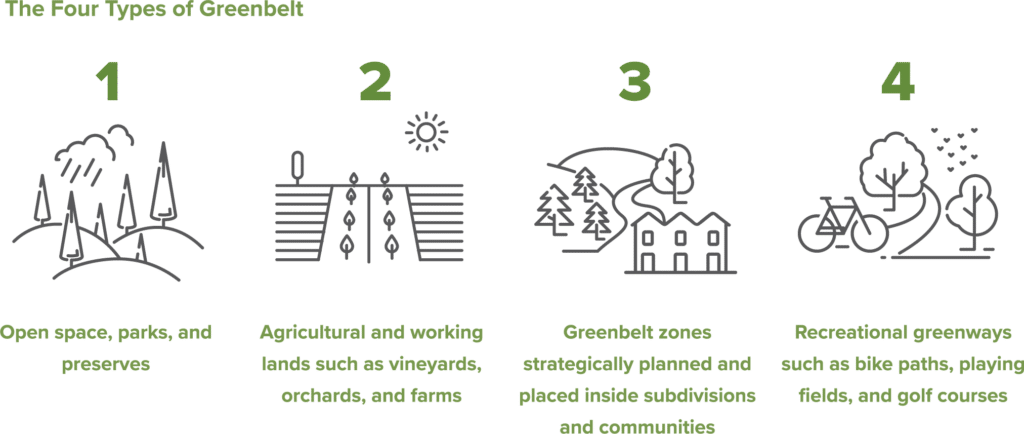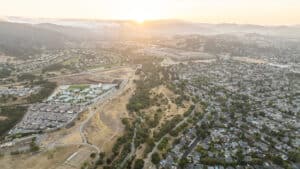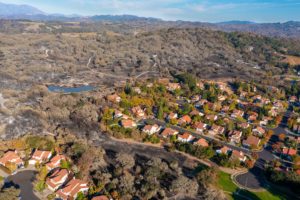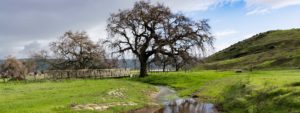A New View of Greenbelts
Through original research and an assessment of case studies, Greenbelt Alliance has identified four types of greenbelts that play a role in reducing the loss of lives and homes in extreme wildfire events while increasing overall resilience in communities and across landscapes.

The role these types of greenbelts play in loss prevention and resilience include:
- Serving as strategic locations for wildfire defense
- Acting as natural wildfire buffers to create separation from wildlands
- Increasing overall wildfire resilience through land stewardship
- Conserving biodiversity on fire-adapted lands while reducing risk
- Providing wildfire-resistant green spaces inside and surrounding neighborhoods
Breakthrough Research
This research makes the case for policymakers to prioritize the protection, expansion, and long-term stewardship of greenbelts in high wildfire risk areas to achieve wildfire defense and risk reduction benefits. It also reiterates the demand for future growth to be channeled within existing cities and towns to address the housing crisis while avoiding new development in the high wildfire risk areas. And it emphasizes the need for enhanced land stewardship of greenbelts to unlock their wildfire-resilience benefits with sustainable funding allocated for permanent protection and longterm management.
Click below to download your copy of The Critical Role of Greenbelts in Wildfire Resilience today.
“The Greenbelt Alliance’s report on ‘The Critical Role of Greenbelts in Wildfire Resilience’ offers a pragmatic solution to the wicked problem of existing homes and communities located in areas with high risk of wildfires. This is the way Indigenous peoples survived and thrived in fire-prone environments without needing to ‘fight’ wildfires: they worked with fire to nurture greenbelts around their settlements and sites of cultural and economic sustenance. The Greenbelt Alliance offers a great guide for Californians to relearn these principles of community fire safety and sustainability.” – Timothy Ingalsbee, Ph.D. Executive Director of Firefighters United for Safety, Ethics and Ecology (FUSEE)
POLICY RECOMMENDATIONS
Local, regional, and state policymakers, planners and their consultants, and the advocates and nonprofits working on solutions should put this research into action and deliver on the following recommendations:
RECOMMENDATION 1
Prioritize increasing greenbelts as strategic locations for wildfire defense through policy and planning.
RECOMMENDATION 2
- Enhance stewardship on greenbelts to restore beneficial wildfire regimes and increase overall wildfire resilience of landscapes.
RECOMMENDATION 3
- Incorporate greenbelts into new developments and calibrate them to maximize wildfire risk reduction.
RECOMMENDATION 4
- Explore the feasibility of a new Community Wildfire Resilience Zone.
WHAT THE EXPERTS HAVE TO SAY
HOW YOU CAN HELP
More Research

Be Prepared Gilroy: A Community Disaster Preparedness Toolkit
Your go-to guide with key resources and a roadmap to community disaster resilience.

The Critical Role of Greenbelts in Wildfire Resilience
The Bay Area is at a tipping point in its relationship to wildfire. There is huge potential for the region, and other places across the Western US, to accelerate greenbelts as critical land-use tools to bolster wildfire resilience.

White Paper: Coyote Valley & Groundwater Protection
Coyote Valley plays a crucial role in recharging the San Jose’s groundwater resources. It’s incredibly important to protect this piece of essential green infrastructure from potential contamination.
